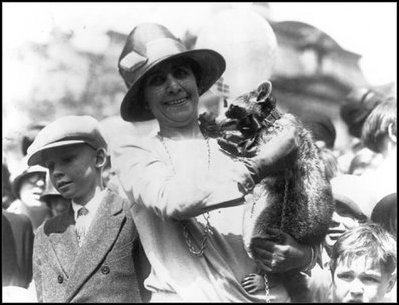
Jan. 24, 1907
Los Angeles
Meet a tough little lady who gave her life to helping the poor, needy children of Los Angeles. She built a church and school starting with a nickel donated by a newsboy, left it all and began again in a tent when the presiding minister turned out to be a crook, and then regained everything. She spent most of her later years fighting with state authorities to stay in operation. Her name is Belle L. White.
White was preaching as early as 1897 at the Pacific Gospel Union, working with needy children in the neighborhood east of Alameda Street. But in a few years, when the Gospel Union decided to give up working with youngsters, White split off and formed her own school at 6th Street and Mateo.
She began with a small, roughly constructed building and raised a larger Mission-style structure called the People’s Church. White was joined by the Rev. T.G. Atteberry, who was soon in debt. There was further controversy about him: “He has actually begun to jump with the Holy Rollers,†The Times says, “they who serve the Lord with ragtime songs and cakewalk accompaniment, and his institutional church at 6th and Mateo streets has become the lodging house, meetinghouse and general headquarters of the ludicrous bunch of fanatics.â€

White continued to have faith in Atteberry when everyone else had abandoned him. “She is a sincere friend of Atteberry and last night fought his battle like the valiant little woman she is,†The Times says. “She pleaded and wept for him, declaring it was her belief that he is simply the victim of circumstances, that he is honest to the core and will pay every dollar owing on the People’s Church, though she says her work is now completely separated from it.â€
And in January 1907, the church wanted to ordain her. “Los Angeles is likely to have the only woman preacher in the country in active charge of a congregation,†The Times says. The paper carried an announcement that White was to be ordained, but there is no further information about it.
Information on White remains sketchy. The institution at 6th and Mateo continued to operate, and by 1909 was known as the nonsectarian Belle White Children’s Home. In 1912, the Belle White Home moved from 588 S. Mateo to the home of former Mayor Hazard at 3701 Eastside Blvd., which had been remodeled as an orphanage.
In 1914, she was investigated on charges of running the home for personal profit and accused of neglecting the children. Later that year, the state Board of Charities and Corrections stripped the home of its license. White defied the ruling and vowed to stay in operation. She challenged the state board to arrest her, and when it didn’t, she continued caring for the children.

The next year, she incorporated and was again investigated by the state Board of Charities and Corrections, which among other things wanted her to restrict admission to either boys or girls and to have a board of directors including men and women. In 1917, there were further charges against White, saying that she operated a boarding home rather than a charity and White conceded that in some instances relatives paid the children’s expenses. It continued to operate as late as 1926, then vanished from the historic record, as did its namesake, Belle L. White.
Lmharnisch.com
Lmharnisch.blogspot.com
E-mail: lmharnisch (AT) gmail.com











